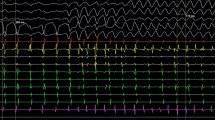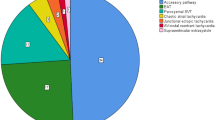Abstract
Several different mechanisms are responsible for paroxysmal supraventricular tachycardia in children. Different forms of tachycardia occur at different age. Atrio-ventricular reentry tachycardia results from the presence of congenital atrioventricular bypass tracts and is frequently encountered at all ages. Infants may present with ectopic atrial tachycardia or atrial flutter. Atrio-ventricular node reentry tachycardia becomes more frequent in adolescence. Atrial scarring resulting from open heart surgery predisposes to complex intra-atrial reentry. Certain forms of congenital and acquired heart disease are associated with specific types of arrhythmia. Many children with paroxysmal supraventricular tachycardia do not require any therapy. The decision to proceed with treatment should be based on the frequency and severity of symptoms and on the effect of arrhythmia on the quality of life. Infants require medical treatment because of the difficulty to recognize symptoms of tachycardia and a risk of heart failure. Patients with Wolff-Parkinson-White syndrome as well as those with significant heart disease are at risk of sudden death. Syncope in children with paroxysmal tachycardia may indicate a severe fall in cardiac output from extremely rapid heart rate. Patients with potentially life-threatening arrhythmia should not participate in competitive physical activities. Treatment options have undergone significant evolution over the past decade. Indications for the use of specific antiarrhythmic medications have been refined. Contemporary catheter ablation procedures employ different forms of energy allowing for safe and effective procedures. Catheter ablation is the treatment of choice for symptomatic paroxysmal tachycardia in school children and in some infants who failed medical treatment. Surgery is the preferred treatment in few selected cases. The goal of this review is to present the state of the art approach to the diagnosis and management of paroxysmal supraventricular tachycardia in infants, children and adolescents.
Similar content being viewed by others
Explore related subjects
Discover the latest articles and news from researchers in related subjects, suggested using machine learning.References
Rodriguez LM, De Chillou C, Schlapfer J, Metzger J, Baiyan X, Van den Dool A, Smeets JLRM, Wellens HJJ. Age at onset and gender of patients with different types of supraventricular tachycardias.Am J Cardiol 1992; 70:1213–1215.
Boldt T, Eronen M, Andersson S. Long-term outcome in fetuses with cardiac arrhythmias.Obstet Gynecol 2003; 102: 1372–1379.
Juneja R, Shah S, Naik N, Kothari SS, Saxena A, Talwar KK. Management of cardiomyopathy resulting from incessant supraventricular tachycardia in infants and children.Indian Heart J 2002; 54:176–180.
Bromberg BI, Lindsay BD, Cain ME, Cox JL. Impact of clinical history and electrophysiologic characterization of accessory pathways on management strategies to reduce sudden death among children with Wolff-Parkinson-White syndrome.J Am Coll Cardiol 1996; 27: 690–695.
Dubin AM, Collins KK, Chiesa N, Hanisch D, Van Hare GF. Use of electrophysiologic testing to assess risk in children with Wolff-Parkinson-White syndrome.Cardiol Young 2002; 12: 248–252.
Pappone C, Manguso F, Santinelli R, Vicedomini G, Sala S, Paglino G, Mazzone P, Lang CC, Gulletta S, Augello G, Santinelli O, Santinelli V. Radiofrequency ablation in children with asymptomatic Wolff-Parkinson-White syndrome.N Engl J Med 2004; 351:1197–1205.
Bisset GS, Gaum W, Kaplan S. The ice bag: a new technique for interruption of supraventricular tachycardia.J Pediatr 1880; 97: 593–595.
Vaughan Williams EM. A classification of antiarrhythmic actions reassessed after a decade of new drugs.J Clin Pharmacol 1984; 24:129–147.
Weindling SN, Saul JP, Walsh EP.Efficacy and risks of medical therapy for supraventricular tachycardia in neonates and infants.Am Heart J 1996; 131: 66–72.
Kugler JD, Danford DA, Deal BJ, Gillette PC, Perry JC, Silka MJ, Van Hare GF, Walsh EP. Radiofrequency catheter ablation for tachyarrhythmias in children and adolescents.N Engl J Med 1994; 330:1481–1487.
Rao PS, Gupta ML, Balaji S. Recent advances in pediatric cardiology -electrophysiology, transcatheter and surgical advances.Indian J Pediatr 2003; 70:557–564.
Kantoch MJ, Frost GF, Robertson MA. Use of Transesophageal Echocardiography in Radiofrequency Catheter Ablation in Children and Adolescents.Can J Cardiol 1998; 14: 519–523.
Haines DE. The biophysics of radiofrequency catheter ablation in the heart: the importance of temperature monitoring.PACE 1993; 16:586–591.
Fitzpatrick AP, Gonzales RP, Lesh MD, Modin GW, Lee RJ, Scheinman MM. New algorithm for the localization of accessory atrioventricular connections using a baseline electrocardiogram.J Am Coll Cardiol 1994; 23:107–116.
Sung RJ, Laurer MR, Chun H. Atrioventricular node reentry: Current concepts and new perspectives.PACE 1994; 17:1413–1430.
Salerno JC, Kertesz NJ, Friedman RA, Fenrich AL. Clinical course of atrial ectopic tachycardia is age-dependent: results and treatment in children <3 or >3 years of age.J Am Coll Cardiol 2004; 43: 438–444.
Triedman JK, Jenkins KJ, Colan SD, Saul JP, Walsh EP. Intraatrial reentrant tachycardia after palliation of congenital heart disease: characterization of multiple macroreentrant circuits using fluoroscopically based three-dimensional endocardial mapping.J Cardiovasc Electrophysiol 1997; 8:259–270.
Author information
Authors and Affiliations
Corresponding author
Rights and permissions
About this article
Cite this article
Kantoch, M.J. Supraventricular tachycardia in children. Indian J Pediatr 72, 609–619 (2005). https://doi.org/10.1007/BF02724188
Issue Date:
DOI: https://doi.org/10.1007/BF02724188




